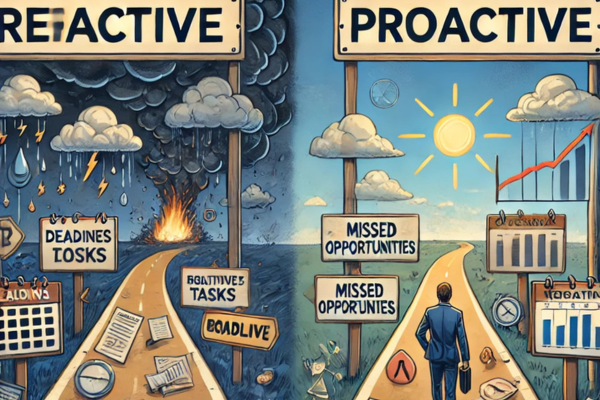Reactive vs. Proactive: How to Shift from Crisis Management to Strategic Growth

When growing your business, the difference between success and stagnation often lies in your approach. Are you constantly putting out fires, reacting to problems as they arise? Or are you taking a proactive stance, anticipating challenges, and setting up systems that allow you to grow with confidence? Staying ahead of the curve is essential in today’s fast-paced business world. Let’s dive into how shifting from a reactive to a proactive mindset can help you build a scalable, efficient business that thrives—no matter what comes your way.
You can run your business in one of two ways:
- Reactive mode is when you just “go with the flow,”. When you don’t have a plan, you just react to what comes your way and deal with it when it does.
- Proactive mode is when you take the time to consider what you want, lay out a plan, and prepare as much as possible for each step that is coming your way.
We all start our businesses in reactive mode—it’s just a natural part of the process.
When you are in start-up mode, it is all about experimentation and proving your business model. You have an idea of what you want to offer and who you want to work with, and you try lots of different things to see what works.
This stage requires you to be a bit reactive – to be able to respond to feedback you receive so you can figure out the right business model and shift into growth mode.
Once you have proven your business model – people are buying what you are offering – then you shift into growth mode, where the focus is to build on that foundation.
Ideally, as you shift from start-up to growth, you also shift from reactive to proactive. Instead of flying by the seat of your pants, you start to plan ahead. You take the time to decide what you want to do in the coming months and years and work together with your team to make it happen.
Not shifting from reactive to proactive mode causes many issues for entrepreneurs at this stage of growth. Many people aren’t sure exactly why they are struggling, let alone how to fix it.
A few things to consider when it comes to shifting from reactive to proactive mode:
- Being reactive is much easier in the moment – It’s a lot easier to simply go with the flow and respond to what comes to you versus taking the time to consider what you really want and how to get there (aka planning). Reactive mode is a hard habit to break for many, especially if we have been operating this way for years.
- Reactive mode can feel “good enough” – This is a dangerous trap and one that my clients were often in for years. And quite honestly, it can be OK. They were making decent money and enjoying their work for the most part. But it really wasn’t by design, and it got to the point where something was definitely missing. No longer wanting to just accept what came their way, they wanted to create work they really wanted to do (which requires planning).
- Reactive mode can actually be a lot of fun – I get it. There is a rush that comes from the energy of “go go go!!!” when you are in reactive mode. It can be draining and frustrating, but also exciting to get up each day not knowing what will come your way and just having to go with it. For some, it can be very fulfilling to tackle the unexpected and come out on top. But again, it’s not intentional.
- Reactive mode affects everyone in your business – In growth mode, it’s not just about you. When you are in reactive mode it forces your team to always be in reactive mode as well, continually scrambling to catch up, always putting out fires, and trying to get things done correctly and on time.
So, are you in reactive mode or proactive mode in your business?
I’d love to talk if you’re in reactive mode and it’s causing problems. As a Certified OBM, one of my superpowers is taking a business from reactive to proactive.

